Zeus
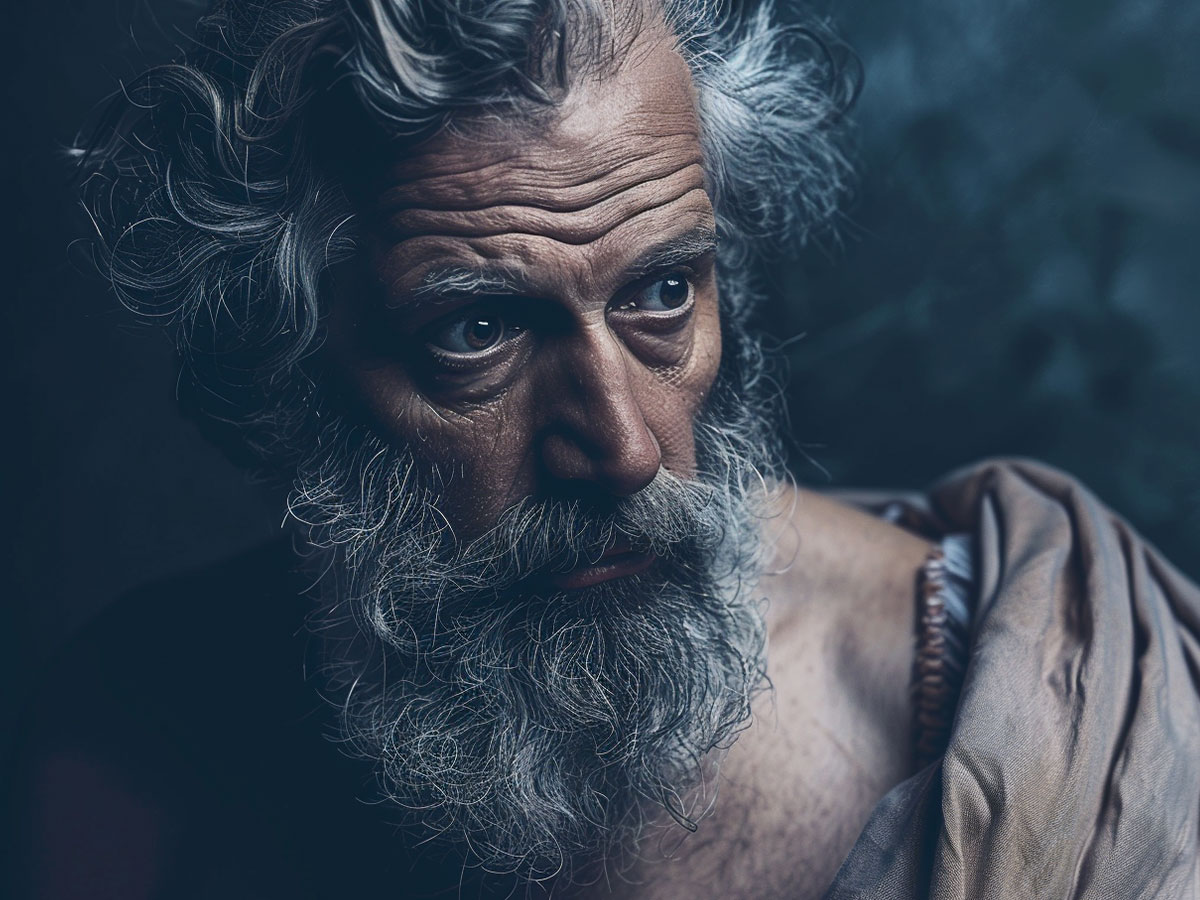
In Greek mythology, Zeus is the king of the gods who reside on Mount Olympus and everyone's favorite deadbeat dad. After narrowly managing to escape being eaten by his father, Zeus would go on to become the god of thunder and the sky in the pantheon of the numerous Greek deities.
This AI-generated image does a pretty good job of depicting this famous deity. The background, coupled with his flowing white hair and beard, definitely give off some serious sky god vibes. But once again, the finer details leave us with some major questions—like why his index finger looks like it's a big toe.
Hera

According to ancient Greek mythology, Hera is the long-suffering wife (and sister—don't ask) of Zeus himself. She is considered to be the goddess of both childbirth and marriage, which is kind of rich, considering her husband cheated on her all the time. Because of all these affairs, Hera is known to be a very jealous and vengeful goddess.
The woman in this AI-generated image is definitely beautiful enough to be a goddess, but we're not sure that she looks like we imagined Hera. Considering she's the goddess of childbirth, we assumed she'd look a little more motherly. And, considering that Zeus can't keep it in his pants, we assumed she'd look a little more angry too.
Poseidon

Poseidon, the brother of Zeus, rules over the seas and is associated with earthquakes and horses. Known for his volatile temper, Poseidon wields a trident, his signature weapon, capable of shaking the earth and stirring the seas. He is typically portrayed as a robust, bearded figure with flowing hair, and — according to A.I. — tattoos.
He's often surrounded by sea creatures like dolphins, seahorses, water nymphs, and even a cyclops or two. During Poseidon's rivalry with Athena over Athens' patronage, he angrily struck the ground with his trident, creating a salty spring (the future Acropolis), but Athena offered an olive tree, a symbol of peace and prosperity. The Athenians chose Athena, leaving Poseidon fuming and the city forever linked to the olive branch.
Demeter

Demeter is the nurturing goddess of agriculture, fertility, and the harvest. She is revered for her role in ensuring the fertility of the earth and the abundance of crops. Demeter is usually depicted as a mature woman with a serene expression, often holding sheaves of wheat or a cornucopia, symbolizing the bounty of the harvest. According to A.I., she's young and fresh-faced, sporting a flower crown and sparkling skin as if a rainstorm had passed over a field of wildflowers.
The most famous Demeter myth involves her daughter, Persephone. Hades, the god of the underworld, kidnaps Persephone with Zeus permission. The heartbroken Demeter unleashes a never-ending winter on the world that kills everyone's crops. Then, she strikes a deal with the devil: Persephone spends half the year with Hades (winter), the other half with Demeter (spring and summer). This cycle explains the changing seasons and highlights Demeter's power over nature.
Hades

In Greek mythology, Hades was the brother to Zeus and Poseidon who presided over the realm of the dead, a place where all souls eventually went. While not inherently evil, he wasn't exactly the life of the party, either. Popular depictions relate him to Satan, adding horns and demonic features to his portraits.
Historical art depicts Hades as a powerful figure with a serious demeanor, often sporting a handsome yet stern expression. Imagine him adorned with rich garments and jewels, a symbol of the vast resources beneath the earth. Some myths even portray him wearing a helm of invisibility, a physical manifestation of the hidden nature of his underworld kingdom.
Athena

Athena (the Greek goddess of wisdom, warfare, and handicraft) burst forth fully formed from the head of Zeus, solidifying her place as his favorite child. Her influence wasn't limited to battlefields. Athena championed skilled craftwork, strategic thinking, and justice, even offering guidance to legendary heroes like Odysseus.
A.I. depicts Athena as a strong woman clad in gleaming armor, wielding a spear and shield, perhaps with an owl adorning her helmet. Her stern expression reflected a sharp intellect and strategic mind.
Apollo

Apollo, the son of Zeus and Leto, is the god of the sun, light, music, poetry, and prophecy. He is often depicted as a handsome, youthful figure with a laurel wreath and carrying a lyre, representing his association with music and the arts. Apollo's imagery often includes a dazzling chariot, which he drives across the sky each day pulling the sun behind him.
Infamously, Eros (the love god) punishes Apollo for being prideful by making him fall for the nymph Daphne. However, Eros also makes Daphne hate anything to do with love. Apollo chases her, but she transforms into a laurel tree just before he catches her. Devastated, Apollo claims the laurel as his sacred tree.
Artemis
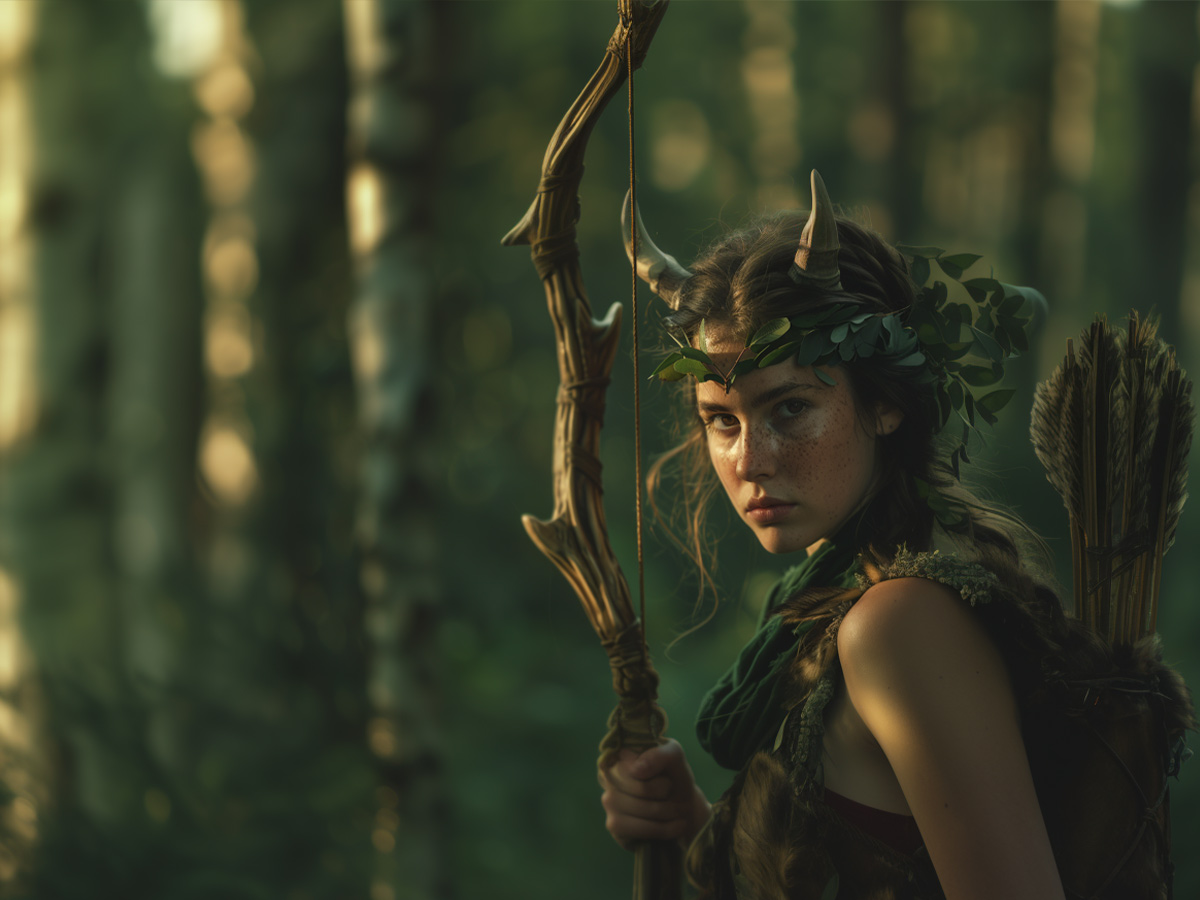
Artemis, who's Apollo's twin sister, is the goddess of the hunt, wilderness, and childbirth. Here, she's portrayed as a young, athletic woman with a bow and quiver of arrows, signifying her skill with the hunt. Artemis is often accompanied by a deer or hunting dogs, and her clothes are practical and simple. Artemis embodies independence and strength, protecting the natural world and ensuring women's safety during childbirth.
In the myth of Actaeon's Punishment, a hunter accidentally sees Artemis bathing and is transformed into a stag, then mauled by his own dogs for disrespecting the goddess. Despite being the goddess of childbirth, Artemis is voluntarily celibate and refuses to marry. How ironic!
Aphrodite
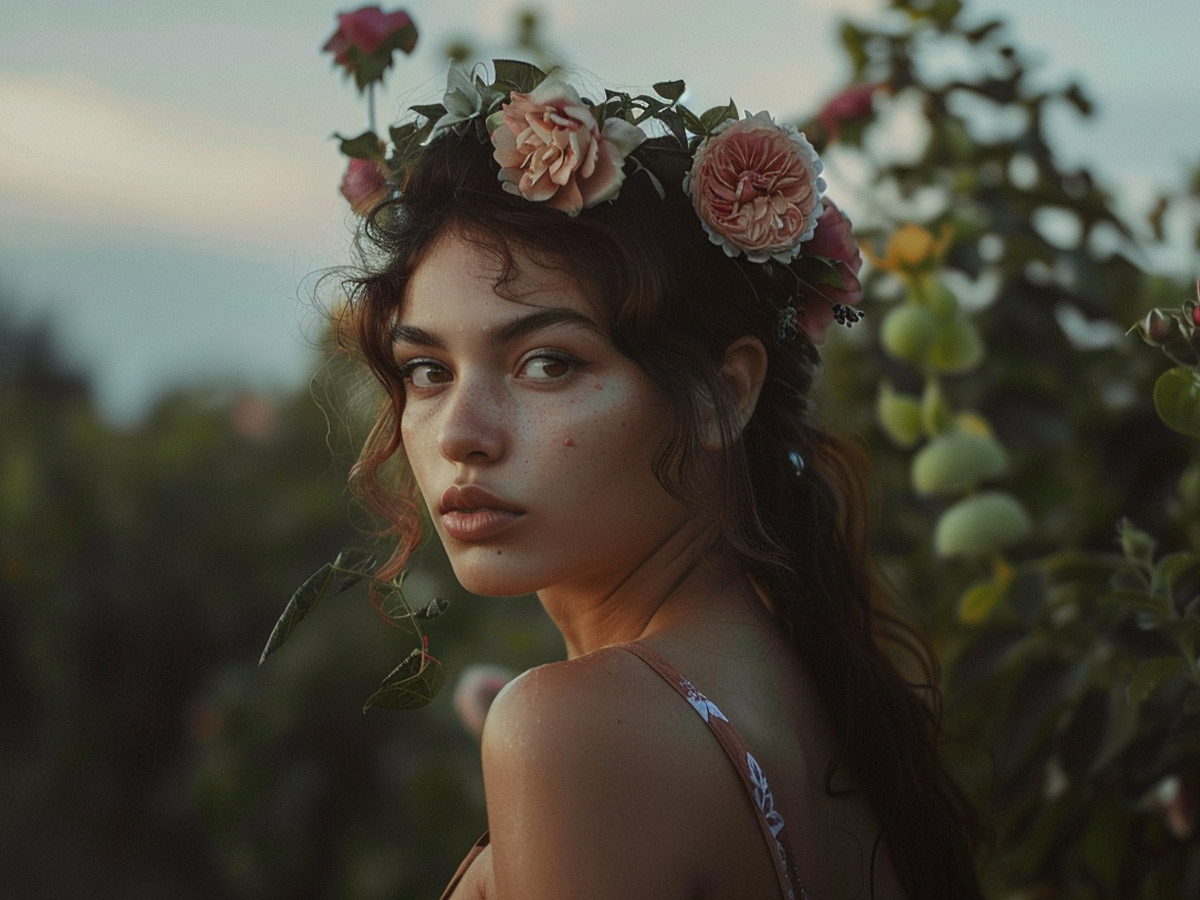
Aphrodite — the Greek goddess of love, beauty, pleasure, and procreation — was born from seafoam or emerged from a split-open seashell, symbolizing her connection to beauty and birth. She's often associated with doves, swans, and seashells, and is notorious for her irresistible charm, especially when used to manipulate the love lives of mortals and gods.
Aphrodite is universally recognized as the epitome of female beauty. Descriptions and artistic portrayals depict her with flawless skin, captivating eyes, and a perfect figure. In paintings, she's often depicted wearing flowing white gowns, blonde hair, precious stones, or adorned with a magical girdle. According to A.I., she's a brunette with flowers woven throughout her curls.
Hermes
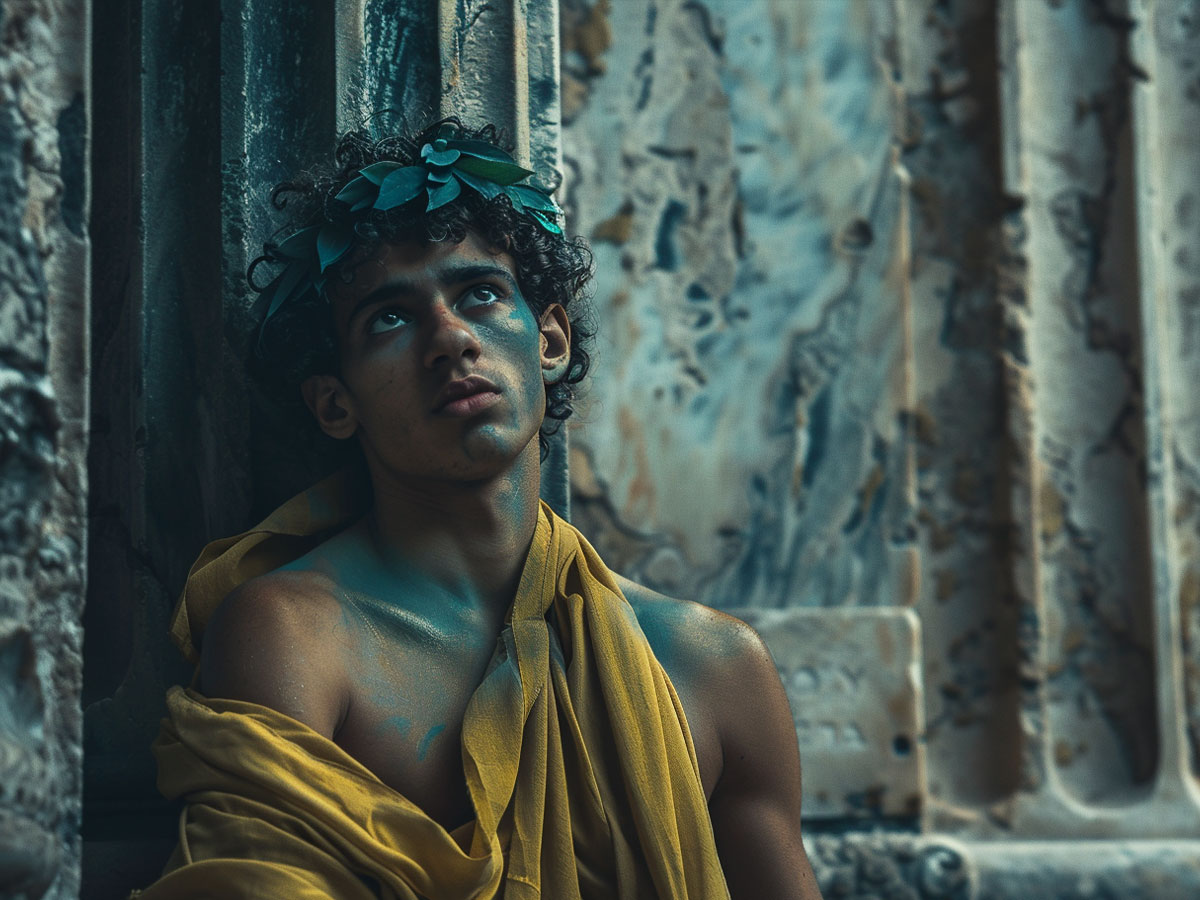
Hermes, the son of Zeus and Maia, is the primary messenger, the god of trade, thieves, and travelers. Known for his speed and cunning personality, Hermes is usually depicted as a youthful, athletic man sporting winged sandals, a winged helmet or headpiece, traveler's clothes, and a purse filled with coins. In popular myths, he carries a caduceus, a staff entwined with two serpents, symbolizing his role as a herald.
During the kidnapping of Persephone, Hermes was sent by Zeus to retrieve Persephone from the underworld to appease her mother, Demeter. This showcases his role as a traveler and intermediary for the gods. He's always sent to do the dirty work for the other gods... Perhaps that's why people say, "Don't shoot the messenger!"
Ares

In Greek mythology, Ares, along with his sister, Athena, was a god of war. Specifically, he was often associated brutality and bloodlust, which makes him sound like a real fun guy. Ares actually doesn't have as many myths as some of the other major Greek gods, and when he does show up, he's often suffering some sort of humiliating military defeat.
This AI-generated image of Ares is actually pretty interesting compared to some of the others. On the one hand, he doesn't feel very Greek to us—he looks more like a knight straight out of King Arthur's court. However, we could definitely believe that this fearsome-looking fighter dude was a god of war.
Hephaestus
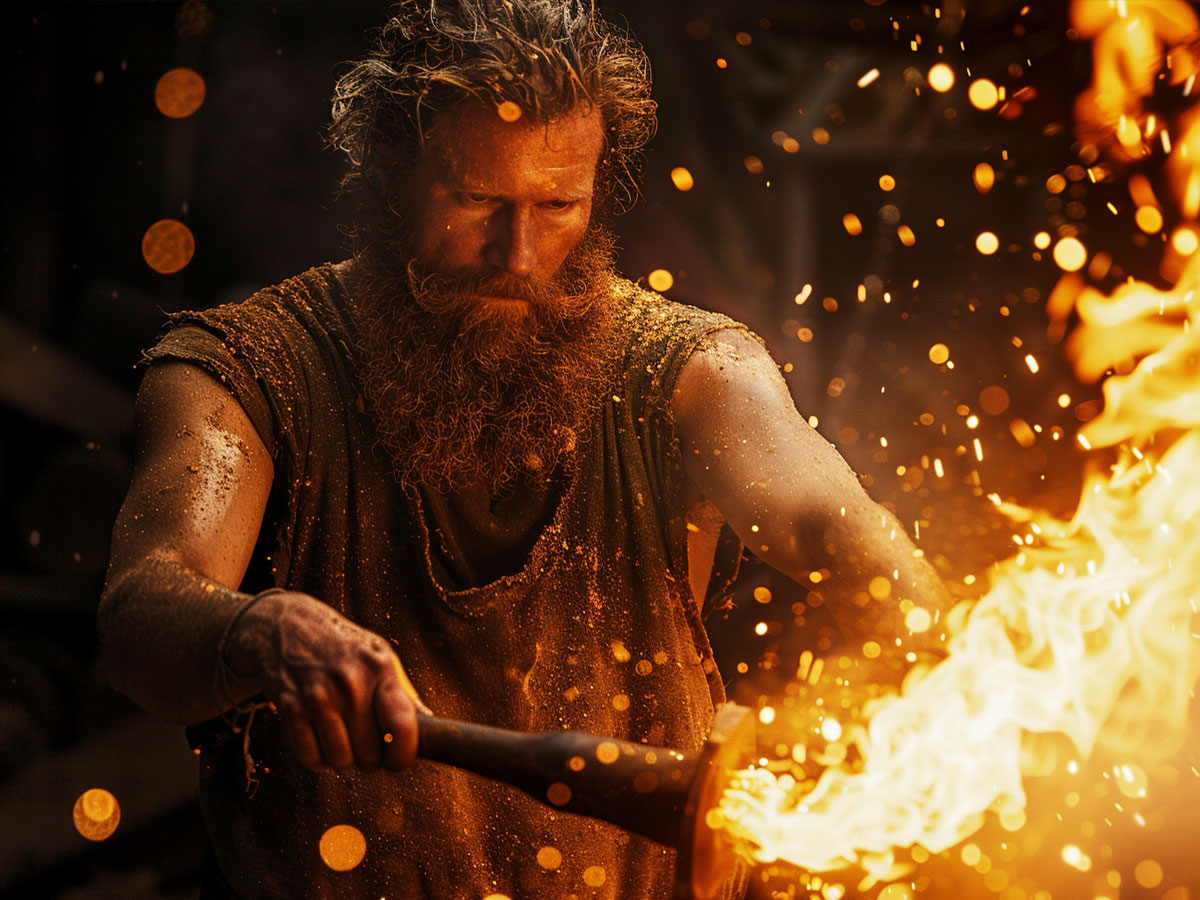
Hephaestus is the god of fire, blacksmiths, craftsmen, and volcanoes. He is known for his creativity and craftsmanship, creating magnificent weapons and armor for the gods. Hephaestus is depicted as a robust, bearded man, often holding a hammer and and surrounded by anvils bathed in fire. However, he's also known for horrific ugliness in most myths.... Apparently A.I. doesn't think so!
Despite being married to Hephaestus, Aphrodite had affairs with other gods, most notably Ares, the god of war. A humiliated Hephaestus crafted an invisible net to trap Aphrodite and Ares in bed during one of their encounters so the other gods could laugh at their shame... Sounds like a healthy relationship!
Dionysus

Dionysus is the god of wine, parties, and ecstasy. He is associated with the intoxicating power of alcohol and celebration, especially when combined. Dionysus is traditionally depicted as a youthful, effeminate figure, often crowned with ivy and holding cup of — you guessed it — wine. Here, A.I. pictures him a bit older, but still with his signature smile that gives him a youthful look.
His imagery includes grapes, vines, and leopards, reflecting his connection to nature and festivity. It's not a party on Mount Olympus without Dionysus. And never trust him to get you home safely! Hermes, the god of travel, is certainly the designated driver (or flier?) in this scenario.
Persephone
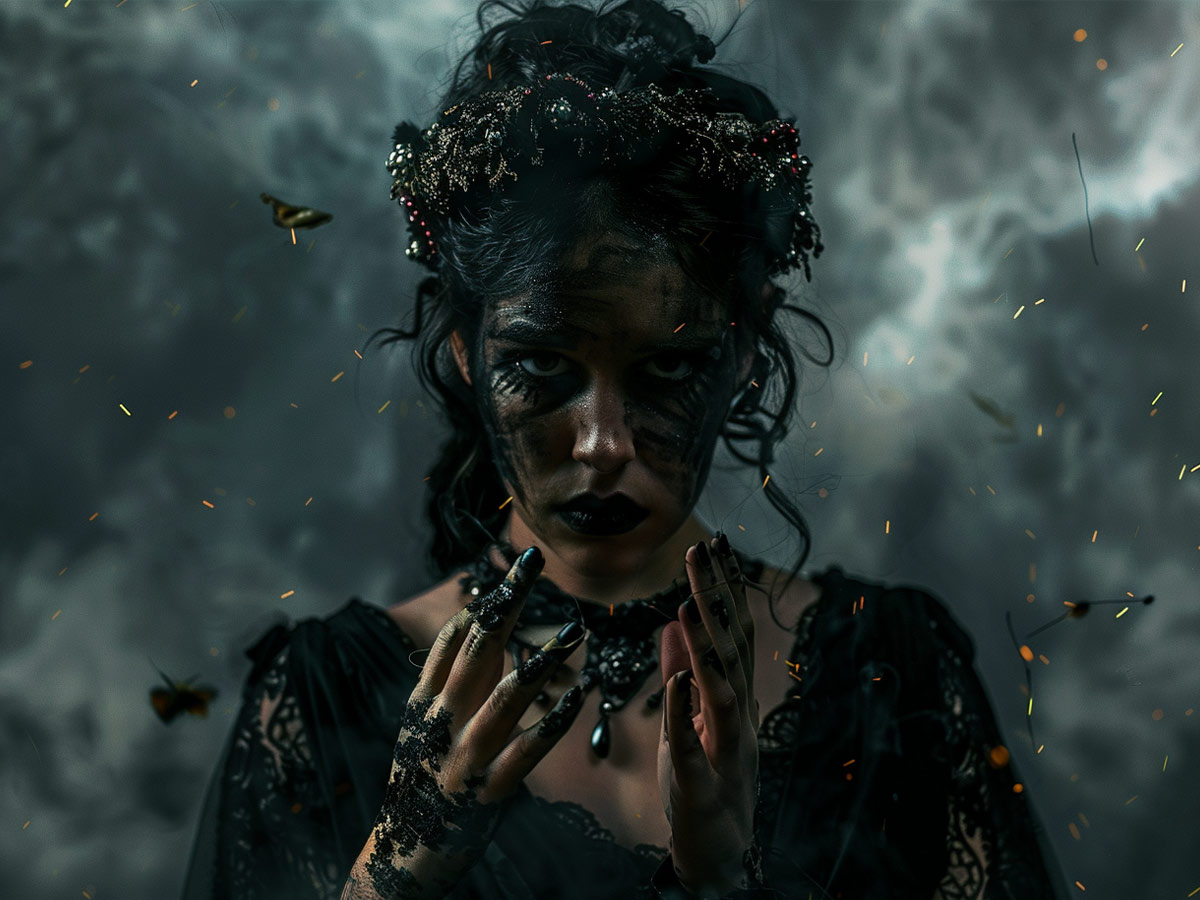
Persephone, the daughter of Demeter and Zeus, is the goddess of the underworld and the queen of the dead. Abducted by Hades, she (reluctantly) becomes his wife and reigns alongside him. Demeter struck a deal with Hades so that half of the year (fall and winter), Persephone is stuck in the underworld. For the other six months (spring and summer), she gets to walk the earth.
Persephone is depicted as a beautiful, serene figure, often holding a torch or a sheaf of wheat, symbolizing her dual role as the goddess of spring growth. But during the months in the underworld, she's a queen of darkness, subjected to every one of Hades' whims. Typically, she's associated with pomegranates, which embodies the inevitability of death. Somehow, those two things are related in Greek mythology!
Hestia

Zeus' sister Hestia is the goddess of the hearth, home, and family. She represents the warmth and stability of the household, domesticity, and general familial well-being. She's depicted as a modest, veiled woman, often holding a flame or a hearth, symbolizing the fireplace. Her presence is calm and nurturing, embodying the spirit of hospitality and the sacredness of the family hearth.
Hestia's role in Greek mythology is unique, as she relinquishes her throne on Mount Olympus to keep the hearth fires burning, reflecting her selfless and devoted nature. According to A.I., she's young, beautiful, and demure, resembling who most Christians would associate with Mary, Jesus' mother.
Eros
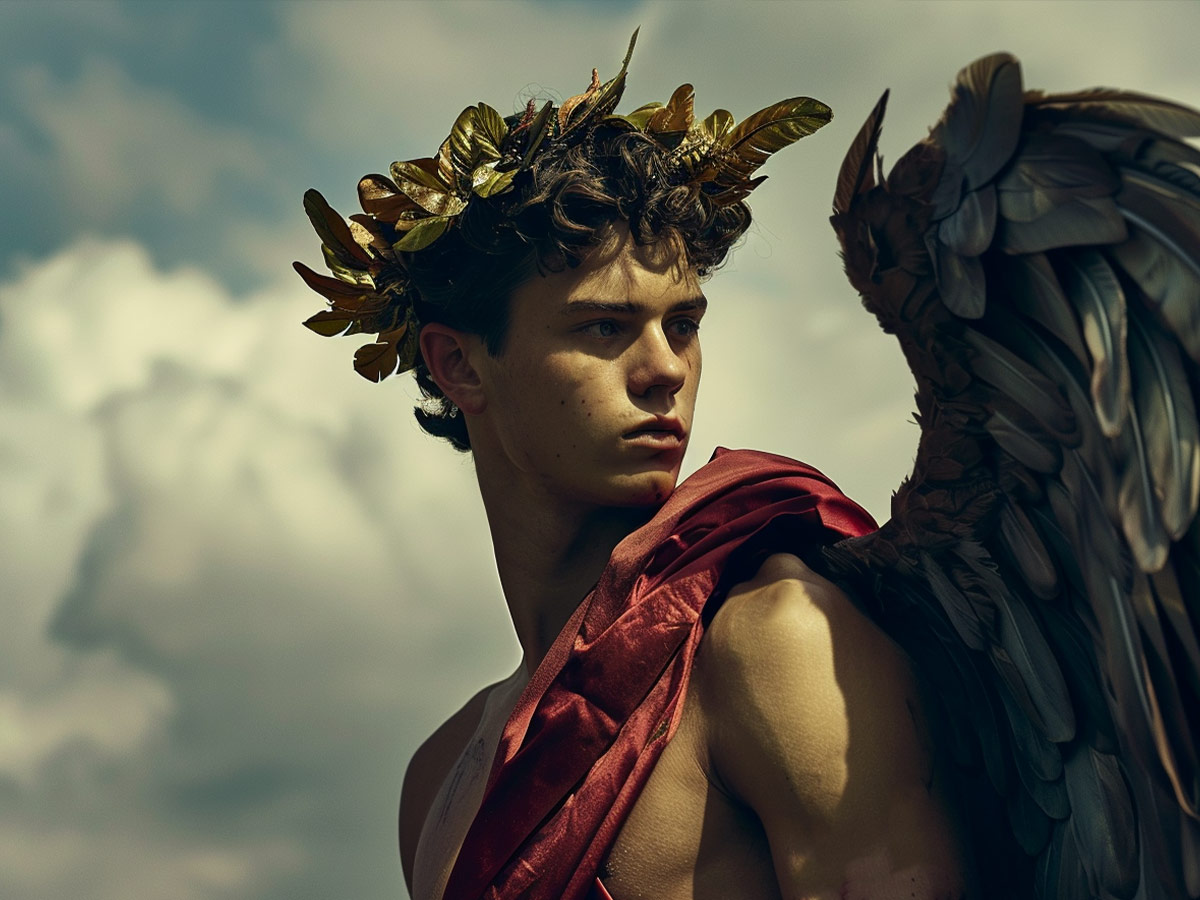
Aphrodite's son, Eros, is the god of love and desire. He represents the passionate, mischievous, and sometimes naive side of attraction. Otherwise known as Cupid, he's depicted as possessing his mother's otherworldly beauty and strong angel wings. Of course, he can't be caught without his bow and arrows, which he shoots at victims of his many love schemes.
In Roman mythology, Eros is replaced by Cupid. While Cupid retains the essence of the love god, his artistic portrayals sometimes veer towards a chubby child with wings, as opposed to the youthful Greek ideal. Despite these minor differences, Eros and Cupid represent the same powerful force – the universal language of love.
Nemesis
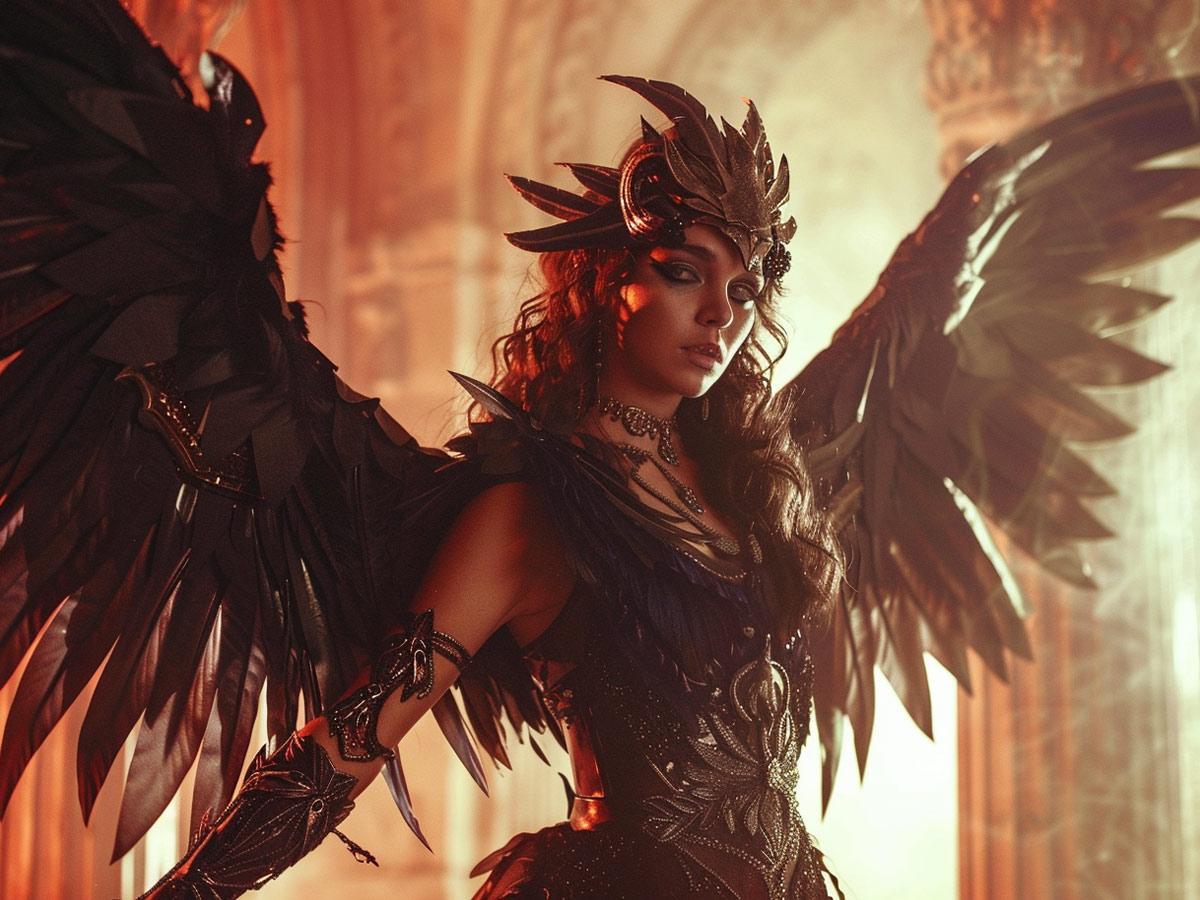
Obviously, Nemesis represents retribution, vengeance, and justice. She balances fate with consequences, especially for those with excessive pride. Nemesis is depicted as a stern, winged figure, often holding a sword or scales, symbolizing her role in delivering justice.
Among her most famous myths include her punishment of Narcissus. The handsome but arrogant youth Narcissus is obsessed with himself, and to punish his vanity, Nemesis ensures that Narcissus falls in love with his reflection, ultimately leading to his death.
Nike

We know what you're thinking — isn't "Nike" the shoe brand? Well, it gets its name from the Greed goddess of victory, Nike. Nike represents the glory and honor of victory in battle. She's depicted as a winged figure, often holding a laurel wreath or a palm branch, symbols of victory and peace. Plus, she's always riding a chariot — what Greek warrior didn't?
Nike's woven into many famous myths, particularly when the Olympians and Titans battled for control. In myths like the clash between the Olympian gods and the Titans, Nike stands beside Zeus, symbolizing his inevitable triumph.
Pan
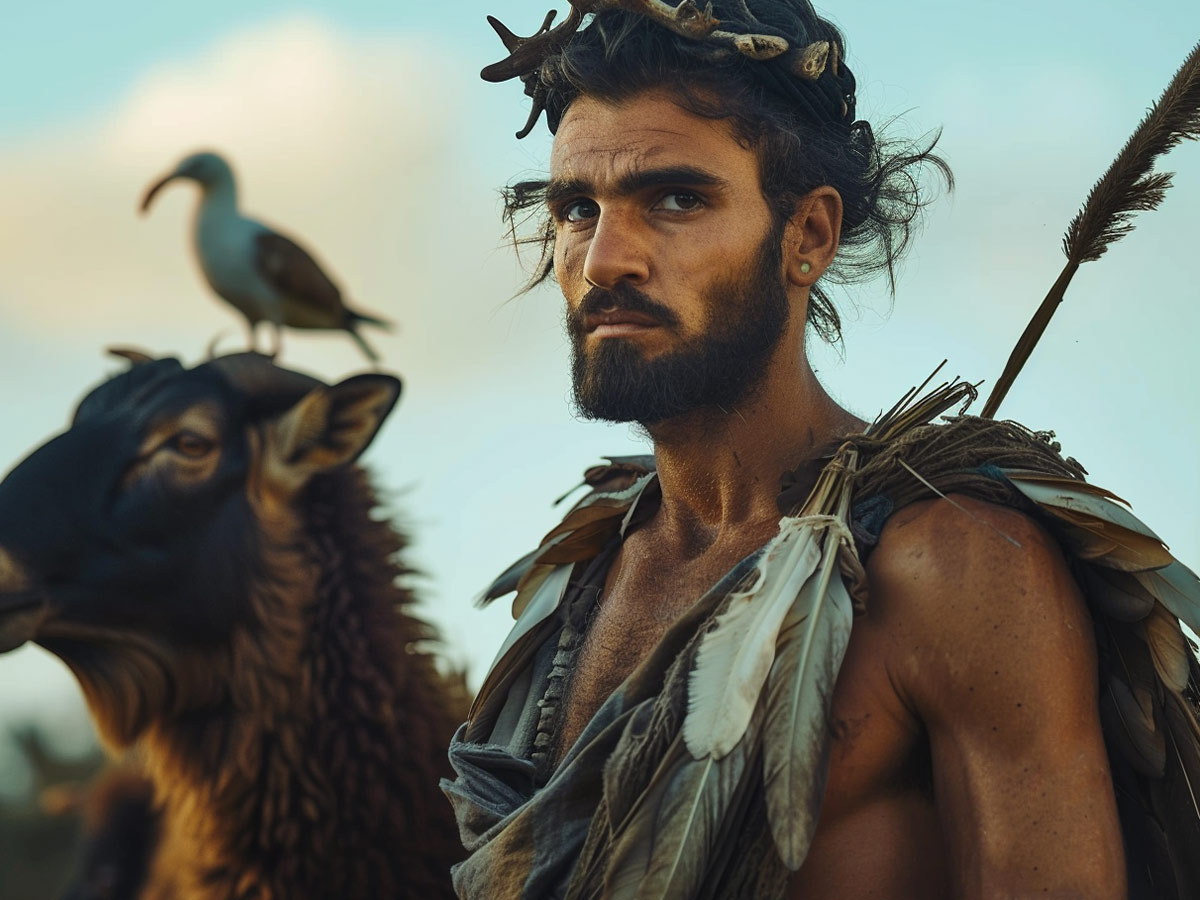
Pan is the god of the wild, shepherds, and flocks, embodying the wilderness. Pan is traditionally depicted as a satyr, with the legs and horns of a goat, playing a pan flute. His imagery includes forested landscapes, flocks of sheep, or anything related to nature.
Once, Pan chased a beautiful wood Syrinx, a beautiful wood nymph, who pleaded with the river god for help. Syrinx was transformed her just as Pan reached for her. Devastated, Pan cuts some reeds and crafted them into a pan flute.
Iris

Iris should always be drawn with a rainbow, which the A.I. captured perfectly. She's the messenger goddess associated with the rainbow, serving as a communicative link between the gods and humanity. Iris is depicted as a graceful, winged figure, often carrying a pitcher of water from the River Styx.
Her imagery includes rainbows, symbolizing her role as a divine messenger and her connection to the heavens. Her presence in these stories often acts as a plot device, moving the narrative forward.
Hecate

Hecate is the goddess of magic and witchcraft, representing the mystical and liminal aspects of existence. She is depicted as a triple-formed goddess, symbolizing her dominion over the past, present, and future.
She often holds torches, keys, or daggers, and is accompanied by dogs, or in this case, a black cat. Her imagery includes crossroads, reflecting her role as a guardian of boundaries and transitions.
Tyche
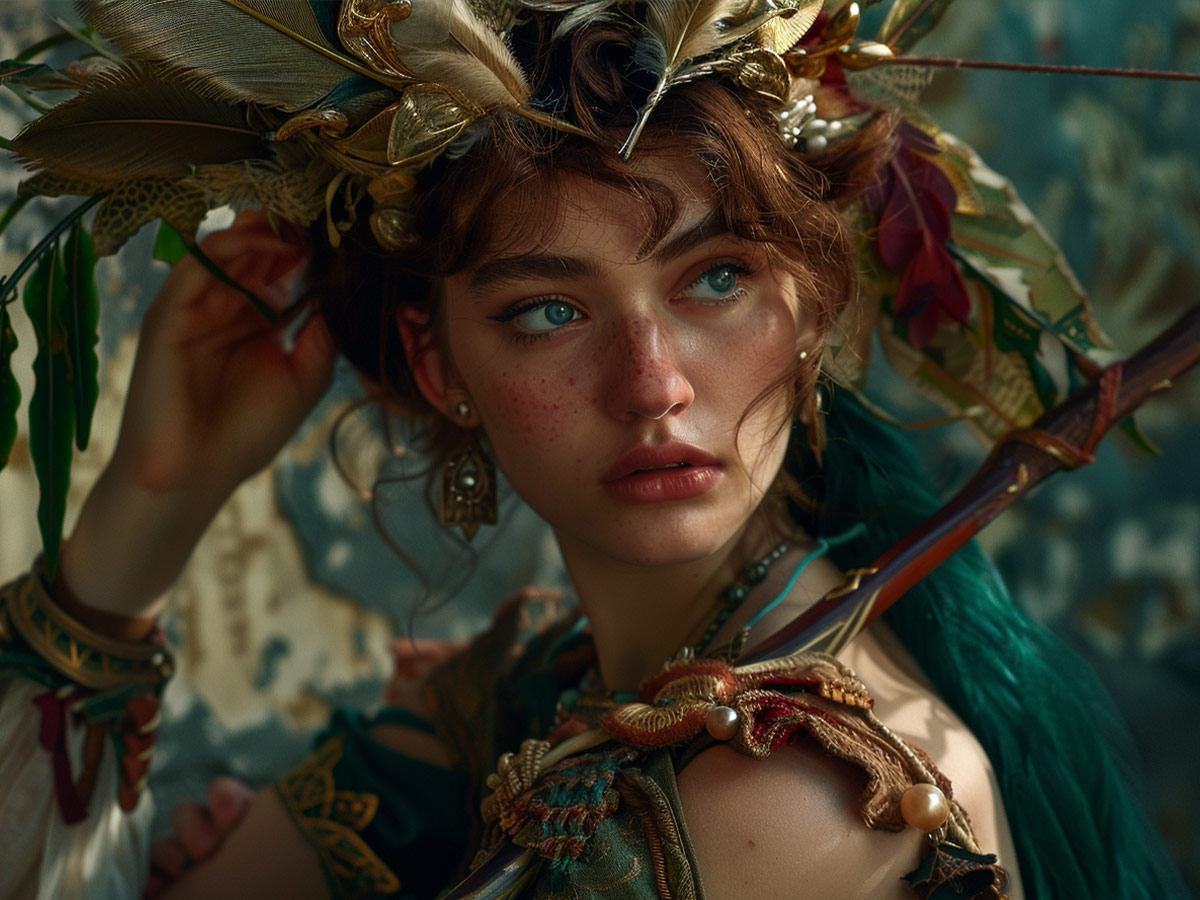
Tyche is the goddess of fortune, chance, and prosperity. She represents the unpredictable nature of luck, often holding a cornucopia to symbolize abundance, and a rudder, signifying her control over destiny. Her imagery includes wheels, representing the cyclical nature of luck and fate.
In many depictions, Tyche is depicted as a beautiful woman, and the A.I. has decided to make her a personification of the cornucopia itself rather than just holding it.
Selene
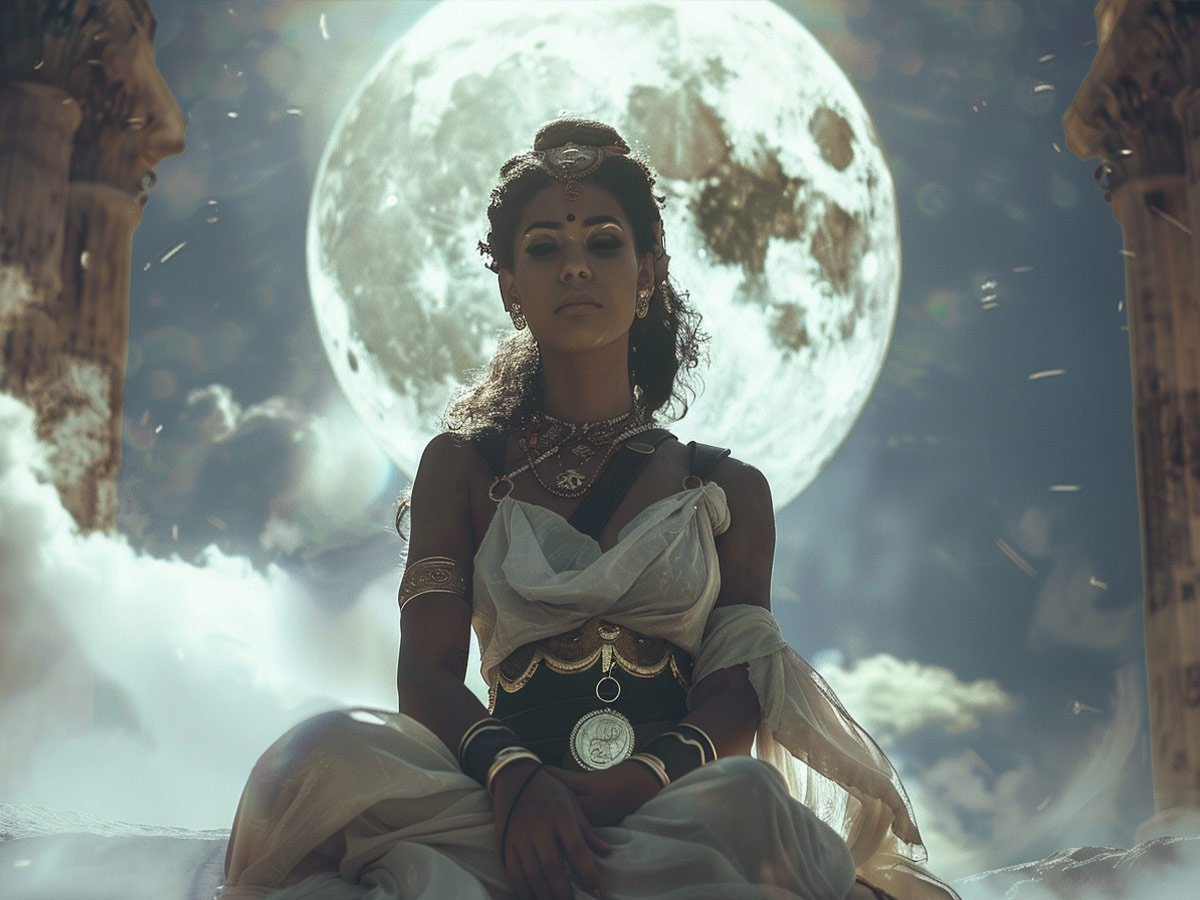
Selene is the goddess of the moon and is associated with how time is cyclical. In Greek art, she's a radiant, ethereal figure, often driving a chariot pulled by white horses across the night sky. Her imagery includes the crescent moon and stars, symbolizing her dominion over the nighttime.
Helios

Helios and Apollo, both linked to the sun, have key differences. Helios, an ancient Titan, embodies the sun itself, driving a chariot across the sky. Apollo, a younger Olympian god, represents not just the sun's light but also music, poetry, and is also depicted as driving the sun, but the mythos is debated.
Helios is often a handsome youth with a radiant crown, while Apollo carries a musical instrument and arrows. Over time, their roles merged, with Apollo becoming the stronger sun god. But remember: Helios is the physical sun, while Apollo is the light, music, and the ideals they represent.
Morpheus

Morpheus is the god of dreams who represents the power of the dream world over the physical. In classic depictions, Morpheus is depicted as a gentle, winged figure, often holding poppies or reclining in a tranquil pose, symbolizing sleep and dream.
According to A.I., however, he's a much darker, creepy figure surrounded by crows and ravens, personifying the dream world as also the world of nightmares.
Themis
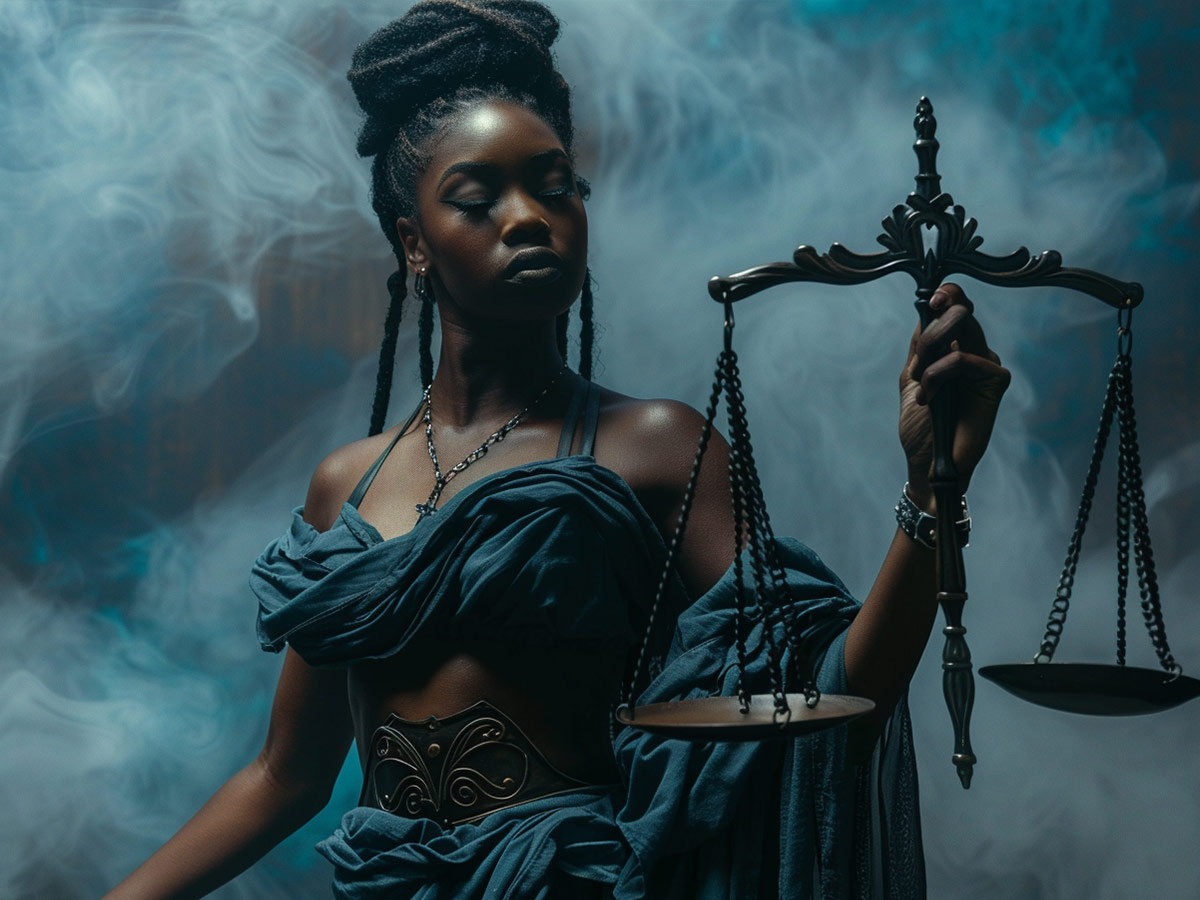
Themis is the goddess of divine order, law, and justice who represents fairness and the rule of law. She's typically depicted as a dignified, blindfolded woman holding a pair of scales and a sword, symbolizing impartiality and the enforcement of justice.
Themis establishes the Oracle at Delphi and predicts a son of Thetis will be stronger than Zeus, shaping the godly lineage. While Themis might not have a starring role, her presence as a powerful oracle makes her a significant figure in the grand tapestry of Greek myths.
Nyx
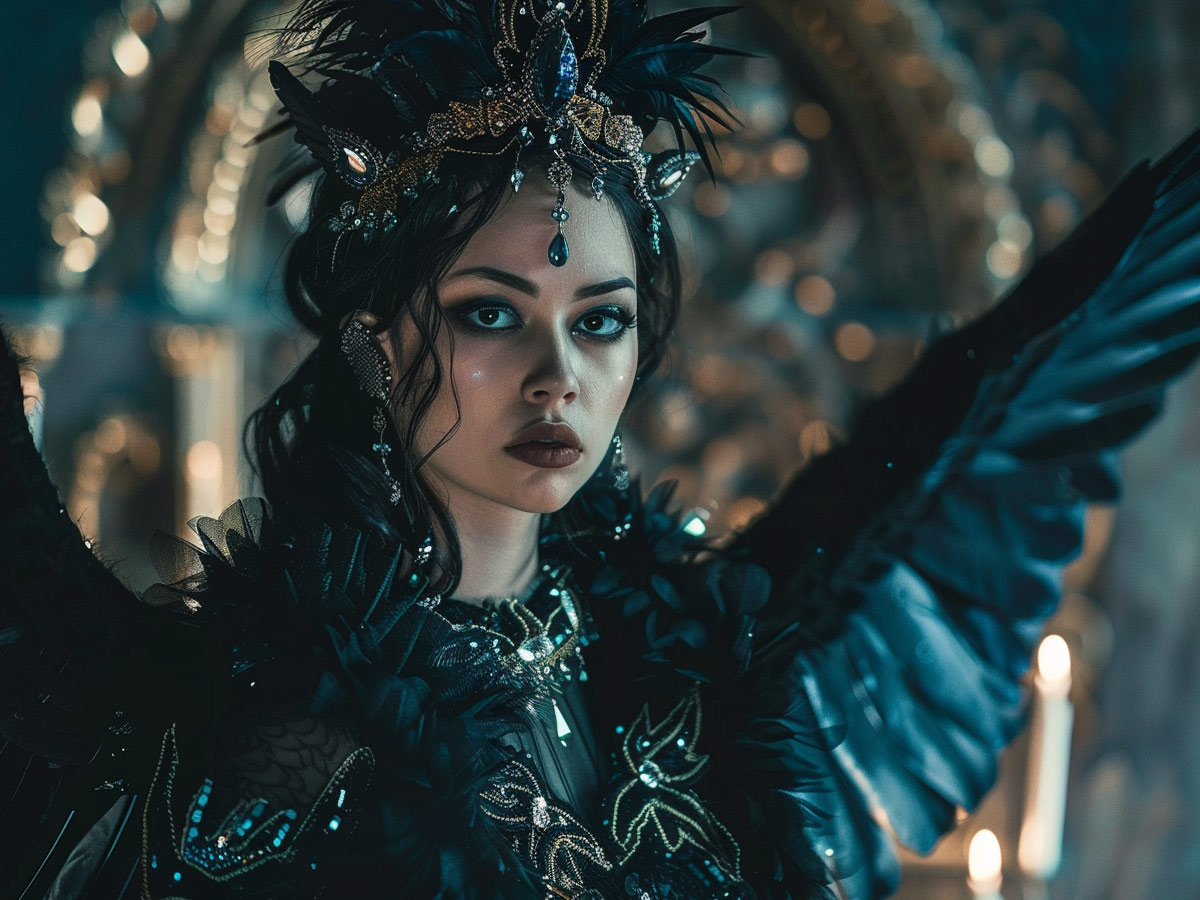
Nyx is the goddess of the night, embodying the mysteries and beauty of the nocturnal world. She represents the darkness and the power of the night. Nyx is depicted as a shadowy, majestic figure, often with a veil of stars and a chariot drawn by dark horses.
Her imagery includes a cloak of darkness and black wings that symbolize her dominion over the night. She existed before the Olympians, she birthed Sleep, Death, and the Fates. Even Zeus respected her power!
Hercules
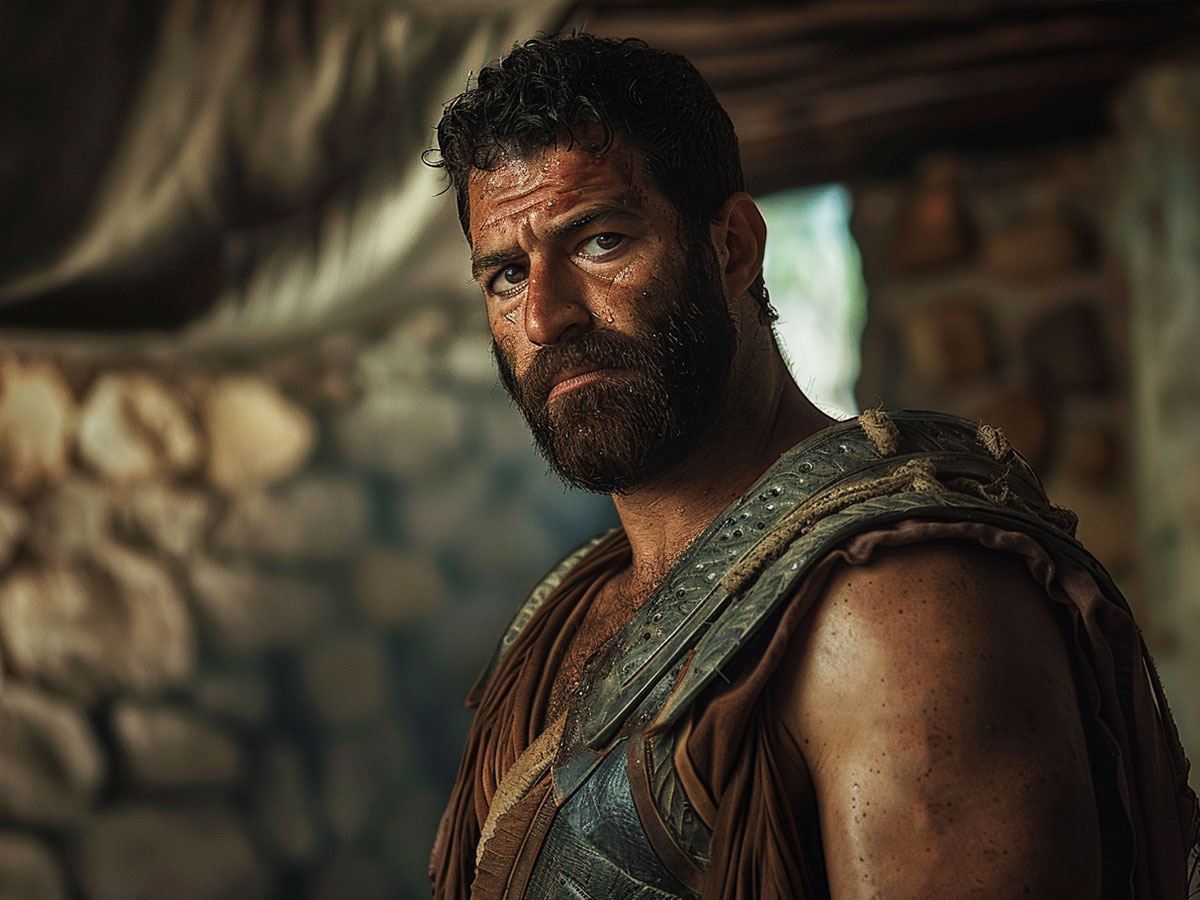
Hercules, also known as Heracles, is a demigod hero renowned for his incredible strength and heroic feats. The son of Zeus and the mortal Alcmene, Hercules is famous for completing the Twelve Labors, a series of nearly impossible tasks.
He is depicted as a big, muscular man, often carrying a club and wearing a lion's skin, symbolizing his victory over the Nemean Lion. A.I. pictures him less like the Disney version of him but as a tall, dark, and handsome warrior.
Medusa

Medusa is one of the Gorgon sisters, known for her terrifying appearance and the ability to turn anyone who gazes upon her to stone. Once a beautiful maiden, she was cursed by Athena, transforming her hair into snakes.
Medusa is always depicted as a monstrous figure with snakes for hair and negative expression. Her imagery includes stone statues, reflecting her deadly power and tragic backstory.
Achilles

Achilles is a legendary Greek hero who was the central protagonist of the events of the Trojan War in Homer's Iliad. The son of the sea nymph Thetis and the mortal Peleus, Achilles is known for his unparalleled skill in war and near invincibility. While not exactly accurate to Iliad, the heel is the only vulerability.
He is depicted as a handsome, athletic warrior in full armor, often shown in the heat of battle, and his imagery includes the shield and spear, symbolizing his role as the best fighter in the world.
 Author
Darby Tanner
Last Updated: September 11, 2025
Author
Darby Tanner
Last Updated: September 11, 2025